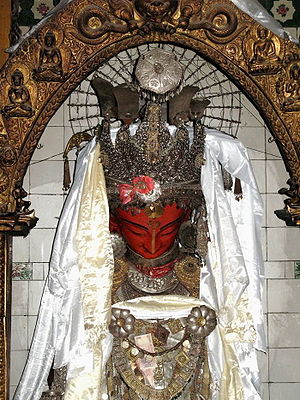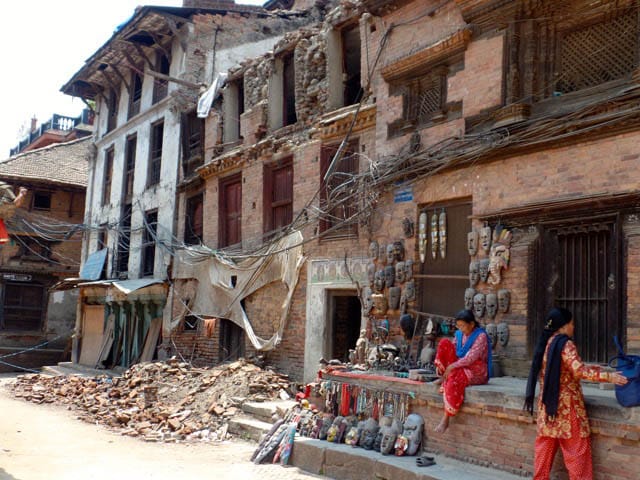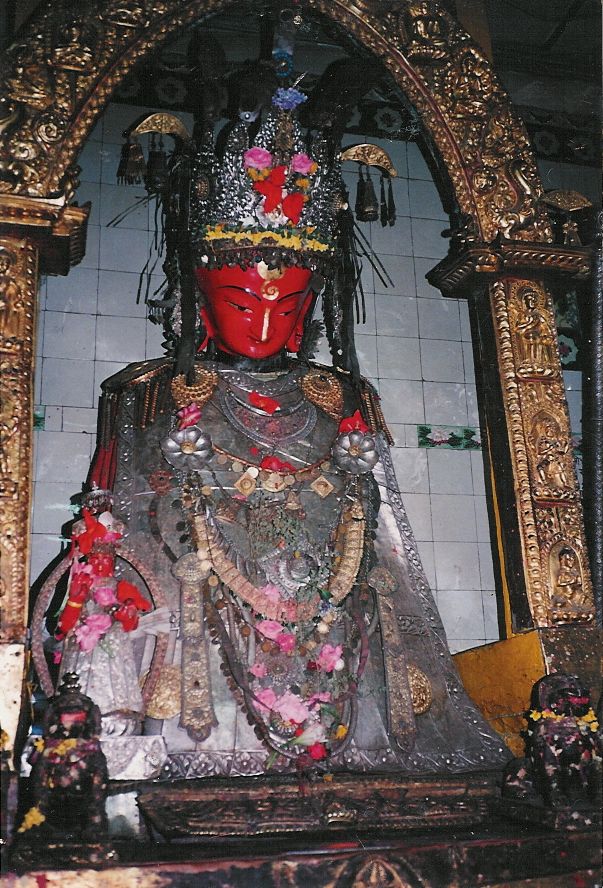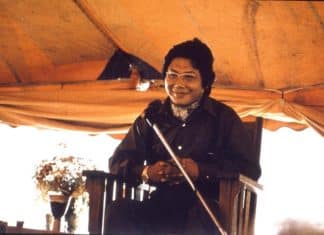
 As we sit helplessly in Erie, Colorado and try to comprehend the incomprehensible tragedy still occurring in the Kathmandu Valley and across the Himalayan region, my wife Pemba and I cannot begin to encompass in our minds what has happened to Kathmandu and Nepal. There is only the indelible roar of the earthquake in our consciousness, and ghostly images of the sudden death of thousands. And thoughts of the desperate plight of survivors, whether still buried in rubble or digging through the rubble attempting to uncover those beneath. Pemba’s family in Nepal is OK, and at least the first wave of information has reported that our closest friends have survived. An entire civilization is living on the streets, either next to the crumbled ruins of their houses and the still buried corpses of their families or next to their yet standing houses, too terrified to enter as the next tremor could collapse any structure into the sea of death and ruin surrounding them.
As we sit helplessly in Erie, Colorado and try to comprehend the incomprehensible tragedy still occurring in the Kathmandu Valley and across the Himalayan region, my wife Pemba and I cannot begin to encompass in our minds what has happened to Kathmandu and Nepal. There is only the indelible roar of the earthquake in our consciousness, and ghostly images of the sudden death of thousands. And thoughts of the desperate plight of survivors, whether still buried in rubble or digging through the rubble attempting to uncover those beneath. Pemba’s family in Nepal is OK, and at least the first wave of information has reported that our closest friends have survived. An entire civilization is living on the streets, either next to the crumbled ruins of their houses and the still buried corpses of their families or next to their yet standing houses, too terrified to enter as the next tremor could collapse any structure into the sea of death and ruin surrounding them.
The Kathmandu Valley sits on the bed of an ancient inland sea. The soil of the Kathmandu Valley is thus very soft and permeable. When quakes of this size occur, the valley soil liquifies, and the shock literally travels in waves of earth back and forth across the valley, deflecting off the bordering rock mountains. So even with such a horrifying Richter Scale magnitude of 7.8, the effect is multiplied. In the larger frame of geological time, of course, the entire Himalayan region consists of the collision of two great continents, and the immeasurable pressure of huge tectonic plates, continually colliding, lifting further toward the heavens the already highest peaks in the world. As one Nepali commented, in the wake of the earthquake, via radio, “The Himalayas are very angry!”
The last quake of this size was in 1934, and was an 8.0 Richter Scale event. The Kathmandu Valley was flattened then also. But back then, housing consisted largely of one story structures with thatched roofs, so though there was great loss of life, it was considerably less than now. And the population of the valley was much less also. People were able to quickly rebuild, and the temples, whose plans were preserved, were reconstructed with the same bricks that came tumbling down, and the same sturdy intricately carved wooden windows.
My wife, Tibetan, grew up in Boudha, Kathmandu, near the Great Stupa. It was to the Kathmandu Valley that many Tibetans escaped, in exile from the Chinese invasion of Tibet, back to what is chronicled in Buddhist legacy as the spiritual fountainhead of Tibetan Buddhism in Nepal. Back to the roots, the wellsprings. Nepal is the place from whence Guru Rinpoche, Padmasambhava, in a prior birth, sprang the aspiration to bring Buddhadharma to Tibet, at the behest of his mother, a simple poultry farmer who with her three sons built the first stupa at Boudhanath. She then dedicated the immense merit to the purpose of the Buddhadharma taking root in the Land of Snows to the North, Tibet. The other two brothers were to be reborn as Tibetan King Trisong Detsen and the great Khenpo-Bodhisattva Santirakshita, who invited Padmasambhava and likewise went about establishing the Dharma in Tibet.
I lived nine years in Kathmandu as Director of the Naropa University Study Abroad Program, right next to the Great Stupa of Boudhanath. Its huge compassionate eyes, painted on the stupa in each of the four directions, caught mine daily, seeing right through me. I feel as though it was there in Kathmandu that I discovered my own wellsprings despite being an American. Those were some of the best years of my life, where I made the closest friends of my life, and met and married the love of my life. I was also living in the immediate neighborhood of Chogyam Trungpa Rinpoche’s closest lineage relatives…Khyentse Rinpoche, Thrangu Rinpoche, Dudjom Rinpoche, Tulku Ugyen, and so on. It was the best of sacred world! And of course my wife swam amidst the rich tapestry of family, friends, and intimately familiar places there her whole life. Though we have lived in the USA since 2007, a good portion of our hearts and life forces still reside in Kathmandu, especially today.
While living in Nepal 1994-2003, I witnessed the explosion of population and construction that sprawled across what used to be rice paddies and separate villages, filling the valley with an urban swath of dismally constructed multi-storied buildings, erected with no consideration for withstanding earthquakes. This even though smaller earthquakes have rocked the valley for centuries. Nepal has been in a deep denial combined with absence of building codes, corruption, greed, misplaced expediency and dysfunctional government. Many of these buildings have now come crashing down onto thousands of people’s lives, along with the buildings of the old Nepal. The exquisite temple, stupa, palace, and old house architecture has defined the Kathmandu Valley as a major world heritage site and destination for millions of visitors, as well as a central pilgrimage destination for Buddhists and Hindus from around the world. Many of those exquisite sacred structures, of course, crumbled like toast in the earthquake. Much of that heritage is now lost to the ages.
Even then, some of the more modern structures seem to comprise the buildings that did survive, probably due to the obstinacy of brick and occasional use of rebar, though no one knows for how long, as after shocks, themselves the size of major earthquakes, continue. The seismologist on the radio says the after shocks will continue for years. And some seismologists state that this devastating earthquake is not yet the big one, which is around 200 years overdue.
It is at least heartening to see the massive response of relief efforts from multiple nations. It seems to take an event as tragic and extensive as this to coalesce the humanity of usually bickering nations.
When I was living in Nepal, around 2001 or so, there was a large meeting at a major monastery, Shechen Gonpa, the seat of Dilgo Khyentse Rinpoche, to address earthquake predictions and preparedness. Two French seismologists addressed a large assembly of monks, Tibetan and Nepali laypeople, and expatriates. I was invited as the Director of the Naropa University Study abroad Program in Nepal. It was at this meeting that the seismologists mapped out the inevitable plight of Nepal with regard to earthquakes, and prescribed precautions and strategies for survival. Their predictive descriptions were verbal depictions of what we see in the news photos from Nepal today. Their French was translated into Tibetan and English. The monks were having difficulty understanding the technical parlance around “tectonic plates”. Then Rabjam Rinpoche, the abbot of the monastery, helping with translation, paused, then referred the monks to their daily ritual use of “mudras”, symbolic hand gestures. Rinpoche pressed his finger and thumb together in readiness for the snap that punctuates the end of such a hand gesture, then concluded with a loud, sharp snap. The monks then immediately nodded in understanding. Nepal, indeed, has now snapped.
Rabjam Rinpoche also observed, at that gathering, that this was not only an education in preparation for such disasters, but being that the monastic community was highly disciplined and steeped in the practice of compassion, they might better be able to help the community in the event of such a disaster. I have no doubt they are all working tirelessly this very moment to help with the catastrophe involving and surrounding them. Rabjam Rinpoche concluded by noting that while earthquake education is invaluable, still, Buddhists should always have the feeling of the roof about to cave in on their head (as the continual reminder of impermanence so central to Buddhist practice).
I also attended a disaster preparedness meeting with the US Embassy in Kathmandu. During a question and answer session, the embassy official was asked whether, in the event of a major quake, Americans should come to the embassy grounds. The official responded that they could try to, but that it may be impossible to find their way along an obliterated landscape that disappeared into a vast trackless expanse of rubble. Better to stabilize where one might be at that time.
When Pemba and I were living in Sikkim, on the fourth floor of a brick apartment building in a dense neighborhood perched on a steep slope, a 5.7 or so earthquake struck in the wee hours of the morning. We abruptly awoke to our room and furniture bouncing about like clothes in a clothes dryer. It was a nightmare, and it even took a few moments to realize we were actually awake. The quake luckily lasted only about five seconds and we were able to exit the building safely. Had it lasted another five seconds, I would likely not be writing this article. There were very few things in Nepal and Sikkim that I feared, but after that, the ever present possibility of earthquakes struck a deep foreboding into my heart and mind. I cannot imagine the abrupt panic that is repeatedly afflicting those survivors in Nepal as each aftershock reverberates.
No one can yet fathom the extent of this tragedy. Perhaps it will never be fully known. It will take weeks, months, and years to slowly emerge from this horror. Over the next several weeks, we expect to hear in increments of the safety or the tragedy of friends and acquaintances. Nepal will never be the same. We will eventually die with a heart already broken from this.
Many tourists who have visited Kathmandu have preferred to visit briefly before hurriedly departing for trekking among the Himalayan peaks. Kathmandu, after all, is an over crowded city severely challenged by widespread poverty, shortage of resources, haphazard development, uncontrolled noxious pollution, borderline hygiene, piles of garbage, corrupt business and government, and traffic either completely gridlocked or else swarming in utterly chaotic and random driving patterns. But for those of us who have stayed and lived in Kathmandu, despite all that, there is a deep, enduring and powerful undertone to the entire valley, with its ancient status as a sacred realm. Its potent legacy as a highly sophisticated Buddhist and Hindu society has endured with a force today equal to the legendary cosmic power of the Bodhisattva Manjushri’s sword. Manjushri wielded that sword, according to legend, to cleave the Chobar Gorge, releasing the waters of the ancient sea, exposing the valley that had been blessed primordially by the combined wisdom of all the Buddhas. This is how the Kathmandu Vally and its civilization was born according to its origin myth, the Swayambu Purana. Manjushri himself then established an enlightened culture on the rich soil of that primordial ground. Even in this modern age, until this earthquake, one could step so easily off the narrow and congested streets of Kathmandu into an enduring world of ancient monuments, temples, stupas, court yards, and innumerable exquisite statues and forms embodying that very spiritual potency.
Even more ancient than history could ever imagine, the Newar Buddhism of the Kathmandu Valley traces itself not only back to Shakyamuni Buddha, but to the previous Buddha, Dipankar, in a prior era. And even after Buddhism was destroyed in India by marauding Islamic armies, Nepal retained, preserved and continued the scriptures, practices, art, teachings, rituals and flavor of the original Buddhist culture.
Far from being an utterly despondent concession to modern development and ruin, though that is undeniably present, Kathmandu has been a not-so-hidden splendor for those of us who fell in love with the valley. We celebrated it with discovery and spontaneous bursts of vivid awareness and appreciation. Native Nepalis, born into this ancient yet utterly present and palpable spiritual environment, celebrate it with daily ritual and calendrical festivals. Now so many of them are buried under the rubble, and much of the vast array of precious culture, art and heritage is now relegated to dust hanging in dangerous clouds over the valley.
For the first three years after my return to the West (having lived in Nepal and Sikkim for thirteen years) I literally dreamed every single night of being in Kathmandu, usually doing what I loved most: wandering through the ancient narrow avenues, encountering favorite or previously undiscovered urban pilgrimage spots, and relishing chance encounters with the warm people of Nepal. I was living two lives, my body in the USA and my mind in Nepal. The dreams of Nepal were always more vivid and real than waking life back here in the USA. Over the last few years the dreams have abated somewhat, but still occur regularly. I have, in the past, entered those dreams with all the happiness and anticipation of meeting an old and treasured friend, and on many occasions, the dreams concluded with my missing, gleefully, my flight back to the USA! Now I am bathed in a deep and bottomless sadness…So many of those people and places survive now only in my dreams. Yet all my sadness is not even a splinter of the tragedy, fear and difficulty facing those who have never left the valley, many of whom are now buried in their own houses.
We should always feel like the roof could collapse over our heads at any time, such is life and its fragility. It often does. But life also, despite all odds, leads relentlessly forward toward rebirth and enduring brilliance, resurgence and endeavor. May Nepal and all who have died be reborn in the splendor and power of their original indestructible vision. And may the surviving Nepal find a great sea of strength to rebuild and go on. Nepal will never be the same, yet will always be Nepal Mandala, it’s original name and spirit.
In the old city of Bhaktapur, in the Kathmandu Valley, there is a small temple hidden far up among the tangled thoroughfares of an old Newar neighborhood. It houses a statue that has been there for hundreds of years, called the “Weeping Tara”. The statue is said to speak on occasion. It is said that once, a few centuries back, this powerful statue of Tara expressed to the temple priest her wish to fly to Tibet. Fearful of her departure, the priest bound the statue in iron chains. The statue of sculpted stone then transformed, bent over into a posture of despondence, and cried tears. I have seen this statue in that temple, still bent over in deep sadness, and her blessing is to bring genuine sadness to one’s own heart. Whether this Tara is buried now, in the rubble of this old temple, or somehow survived the quake, there is no doubt in my mind that she now weeps for Nepal.
Clarke and Pemba Dolma;
Nepal, circa 2005
Clarke Warren is among the original students of Chogyam Trungpa Rinpoche in America, starting in 1970. He has been a core faculty for Nge-don School, an adjunct faculty in Buddhist Studies for Naropa University, a past senior teacher for Shambhala Training, and an avid practitioner of the Vajrayana. He directed and taught in the Naropa University Study Abroad Program in Nepal then Sikkim from 1994-2007. He is one of the founders of the Ri-mé Society in Boulder, Colorado, which endeavors to engage and continue the teachings and practices of Vidyadhara Chogyam Trungpa Rinpocha and the practice lineages of Vajrayana Buddhism. He and his wife Pemba Dolma Warren live in Erie, Colorado.

















